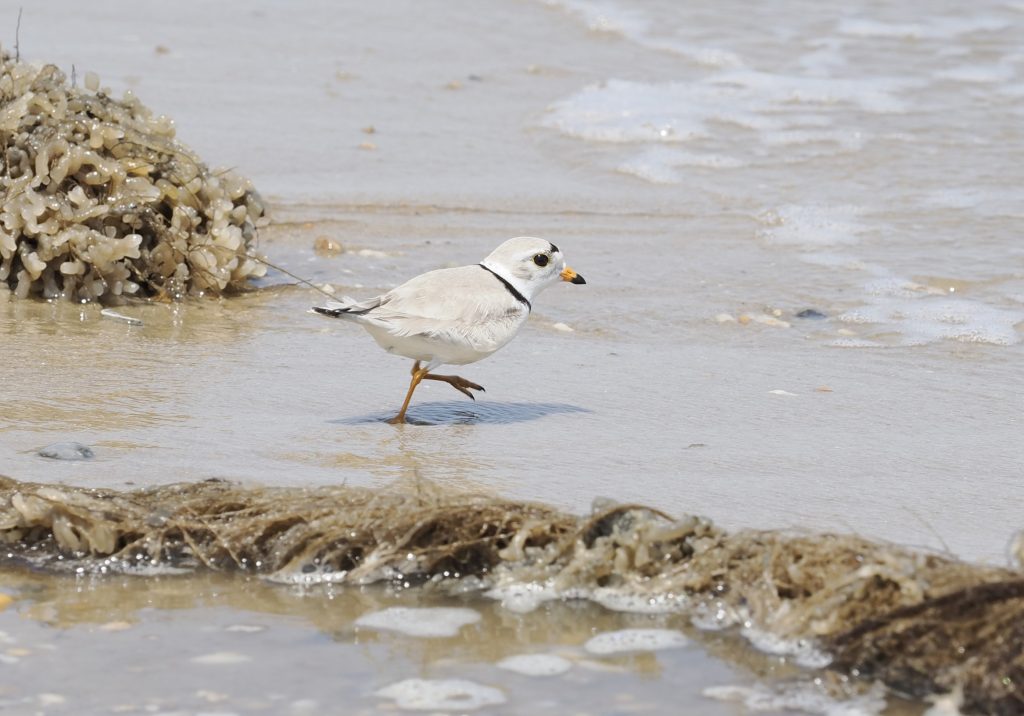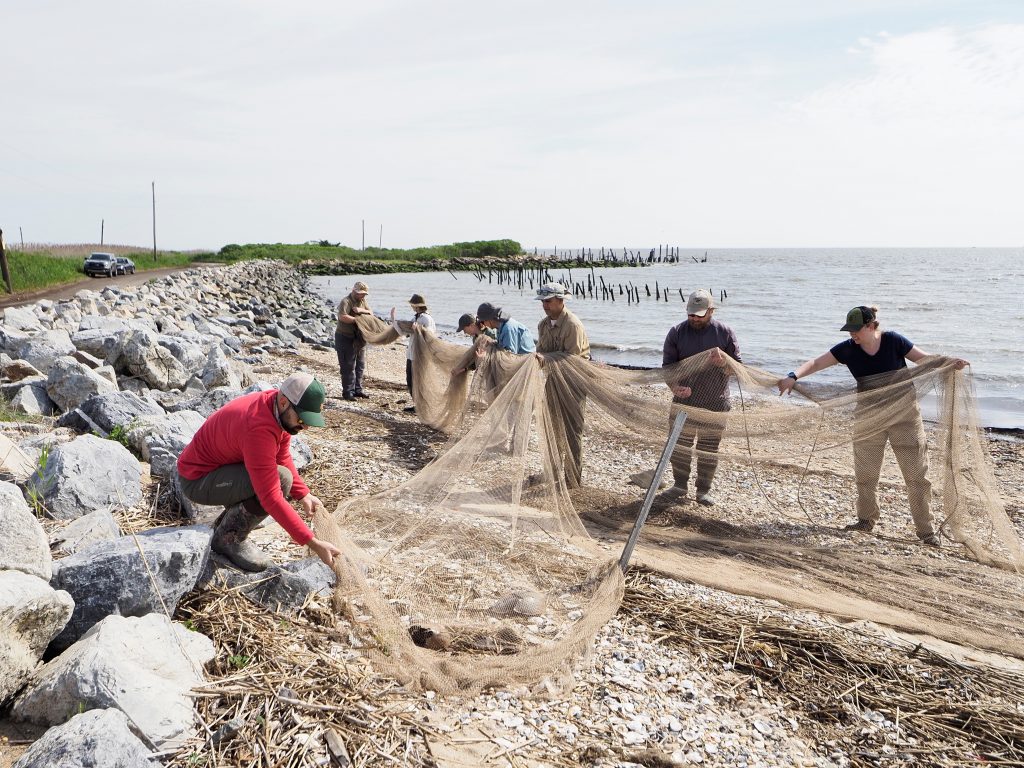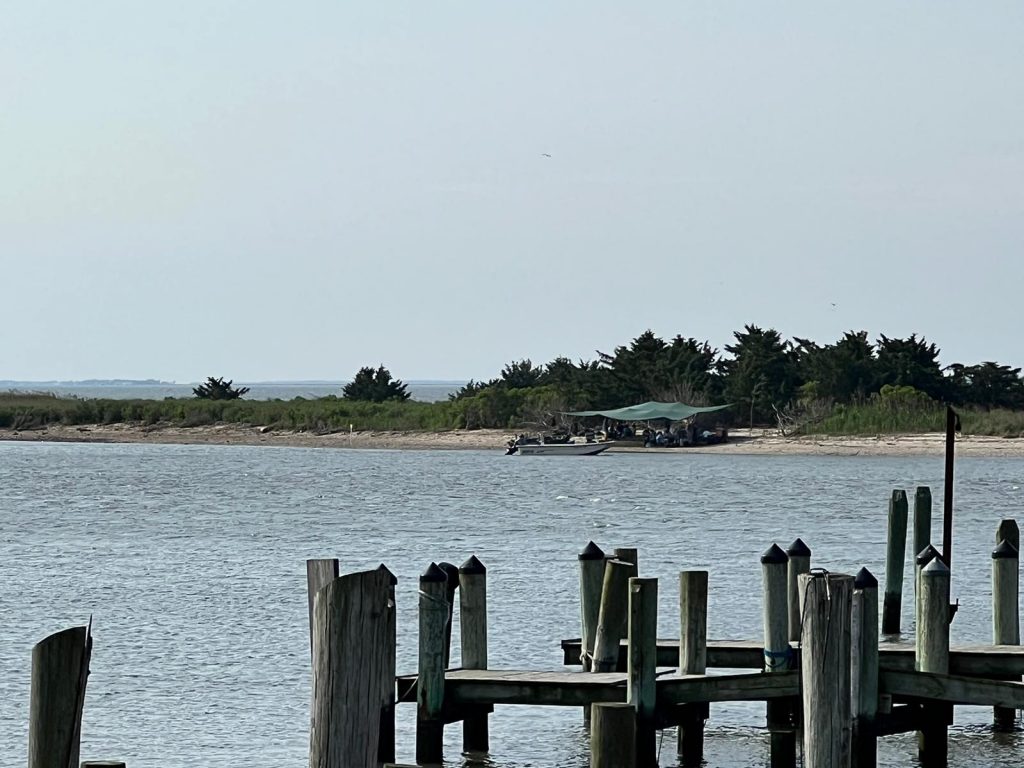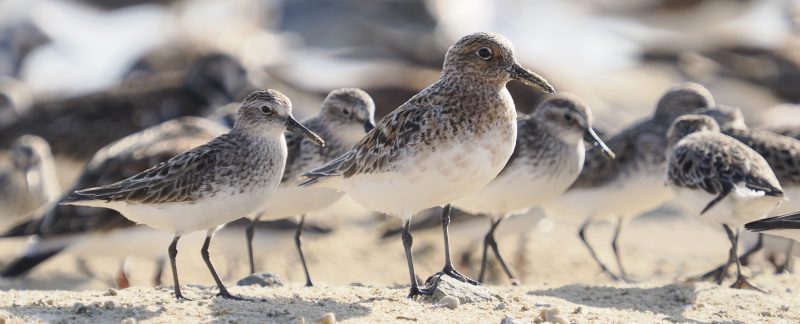Wednesday 10 May
The first team of Brits made it safely across the sea and by the evening were looking over Mispillion Harbour in Delaware Bay, a long way from the UK. The sun dipped lower in the sky and the calls of Laughing Gulls filled the air as shorebirds foraged on the shores. For those who had come many times before, there was definitely a sense of returning to a familiar home. Jet-lag fatigue setting in, it wasn’t long after we arrived at this year’s WWRG base, on Slaughter Beach, that we all went to bed.
Thursday 11 May
The first of the season’s surveys for us commenced at Fowler Beach and pairs of Piping Plovers, many with colour rings, were a cheerful sight. Sam, the project’s leader, came to meet the team today. A group of us went out in the Jon boat to do the first full survey of Mispillion Harbour in the afternoon. Quite a few Royal Terns’ colour rings were read as they perched on old posts. Dave Carter got so absorbed in looking at Red Knot flags that he beached the boat and extra hands were required to heave it back into the water!

A much needed (and colossal) food shop was completed today, and two more volunteers, Ema and Kirsten, arrived at the house. The afternoon consisted of the first data entry, survey planning, and cake and singing for Ema’s and Flo’s birthdays.
Friday 12 May
Several beaches were surveyed in the morning which began with a blue haze but quickly became very warm. A bit of birding in the woods near Ted Harvey saw flycatchers and warblers and many other birds of unbelievable colour and song. An Osprey near the Nature Centre is metal ringed, and Richard began a mission (as yet unsuccessful) to read it.
After a long day of surveying and sorting out the house and all the ‘Brit kit’, a delicious curry and home-made naan bread by Graham was gratefully received.
Saturday 13 May
While surveying Port Mahon, Richard saw a good option for catching Turnstone with a number feeding on the shingly shore. A pair each of Bottle-nosed Dolphins and Ruddy Ducks were also a happy sight. Other beaches and Mispillion Harbour were also surveyed in the morning and afternoon, and the first crab tag of the season was found whilst resighting! The first rains of the trip began to fall and soon all resighters on the Mispillion beaches were more than thoroughly saturated. Spirits remained high and, soggy but smiling, they dripped back to the house, dried up and got on with data.
Cathy, Ema and Sam sorted out lots of flags for the proposed catch and the cars were packed out with all the kit. Late in the evening the rest of the British team arrived and there was a great sense of reunion and happy chatter all around as we had a good catch up before discussing plans for the morning’s catch.
Sunday 14 May
Around 06:00 everyone began to rise and snuffle around for some breakfast. Though the morning was chilly and breezy, there was a beautiful sunrise. Despite a bit of car confusion, everyone made it to Port Mahon more or less on time and met with others associated with the project who were joining the catch. An efficient team swiftly set a half net and basecamp got into position. There were fewer Turnstones on the beach than before, and a bit of twinkling in various places was required. Higher winds than yesterday possibly meant that more crabs were flipped and so less spawning occurred. The net was fired, and we caught 13 Turnstone, four Semipalmated Sandpipers, one Least Sandpiper and, to everyone’s excitement (especially Sam’s), a Black-necked Stilt! Two processing teams and one Turnstone flagging team set to work.

For the rest of the day more beach surveys were made and Mispillion was scouted out for catching options, Osprey and back North beginning to look like good options. Two volunteers from Australia, Judy and Greg, also arrived today and jumped straight into helping with various tasks. Flags were trimmed, carrot cake was eaten, and Richard led a great team meeting to discuss the next day’s jobs and surveys.
Monday 15 May
Another beautiful day of warm breeze, blue sky and sparkling sea, lots more crab flipping (once upside down, they can’t turn themselves back over) and successful surveying was completed. The number of Red Knot at Mispillion is increasing every day and today at least 40 were seen at once.
Cathy and Kirsty were over the moon to have spotted a Red-headed Woodpecker today. Another highlight of the day was Ema’s delicious and seemingly never-ending homemade pizza!
Richard and Sam confirmed that we would be catching on Osprey in the morning, and so the team planning began…
Tuesday 16 May
At 07:15 a small team set out in the Jon boat and quickly set a net on Osprey. Birds began piling in immediately. A few people walked to the site and the rest boated over in the Skiff with all the other equipment and processing things. Richard radioed to the Skiff to get a move on, and fast, as firing was imminent. Kirsty was manning the firing box and did a brilliant job of holding fire when Richard twice began and did not finish countdowns because birds were still pouring in. At last, “Fire!” was called and off went the bang. The temptation felt by those in the Skiff to dive into water and swim to shore was very great. Once the Skiff reached shore, all leapt out and sprinted to join the others at the net. A slick lift was made and covering material was spread out over the catch. Shade was put up over the birds once they were all safely in keeping cages and very soon flagging and processing commenced.

During the calm and peaceful hum of these latter proceedings, an American Redstart and a Northern Parula hopped about in the neighbouring cedars and a few Glossy Ibis flew low over the Rock Wall. Someone explained that the Horseshoe Crabs are actually more closely related to arachnids than true crabs, to which Guy exclaimed: “Are you telling me I am sitting on a beach full of giant spiders!?” Catch totals were: 152 Turnstone, 103 Dunlin, 22 Semipalmated Sandpipers and 11 Short-billed Dowitchers. The Jon boat caused some amusement as it had once again been beached, and so a team of 12 was required to shift it once more into the water.
A few stayed on Osprey to resight, and the rest of the team headed out to survey the other sites. The day was completed with a beautiful spread of samosas, creams and chilly jams made by Graham – very tasty! Rob Rob and Guy kindly gave Flo an amazing lesson on moult and migration in shorebirds and a very interesting graph was constructed.
Wednesday 17 May
Today, Richard, Ryan and Katharine journeyed to New Jersey to chat to the team on the other side of the Bay and visit a company who makes small radio tags.
Meanwhile at Slaughter Beach, the morning commenced with a good load of data checking. We also managed to fit in three boat trips into Mispillion Harbour throughout the day.
Black Skimmers were spotted skimming and roosting in the wetlands near Prime Hook, and several thousand Black-bellied Plovers were observed feeding in ploughed fields nearby.
A decision had been made to attempt a catch at Back Beach in Mispillion Harbour the next morning, following a successful recce by Mark who found and option of around 30 catchable Red Knot. A forecast of strong winds made judging the morning high tide a little difficult, but by the end of the evening a thorough plan for the morning was successfully hatched.
All banding, marking, and sampling is conducted under a federally authorised Bird Banding Permit issued by the U.S. Geological Survey.
Thanks to Florence Turner for writing this blog.

